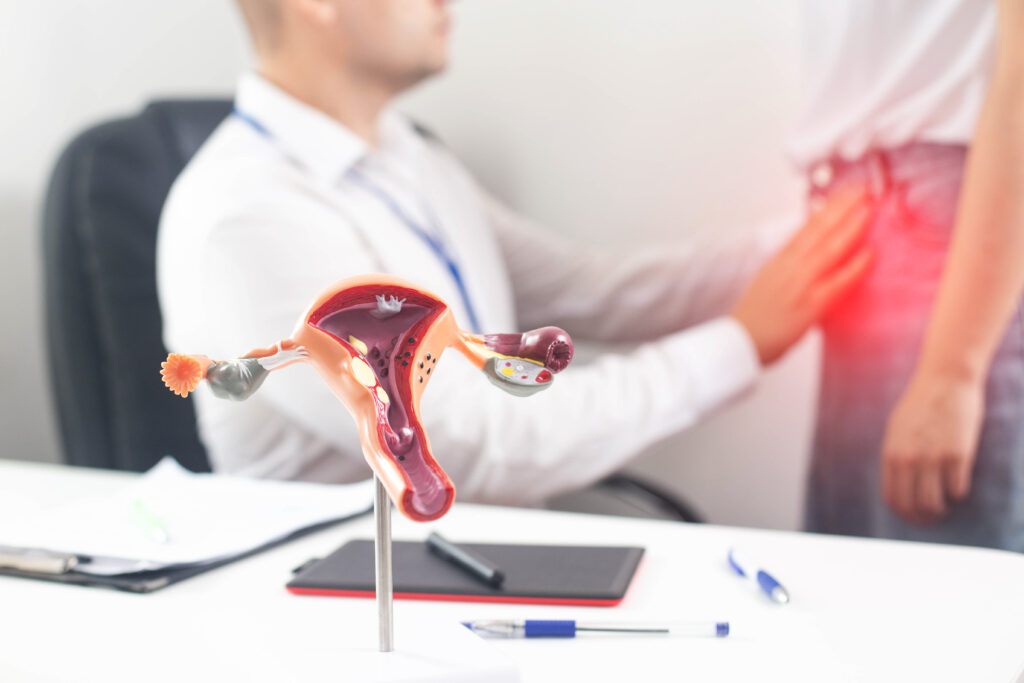A UFE procedure is performed by a highly trained Vascular Interventional Radiologist, done with local anesthestic and under conscious sedation. While the patient is sedated and will not experience pain, they are allowed to remain conscious. A very tiny nick is made in the skin near the femoral artery in the groin or the radial artery in the wrist and a catheter is carefully guided to the pelvic arteries. An angiogram is performed injecting xray contrast to visualize the uterine arteries which are typically very enlarged. There are two uterine arteries, one on each side of the pelvis.
The catheter is then placed deep inside each of the uterine arteries. Once reached, micro-spheres of medical grade plastic or gelatin are injected into the uterine artery to cut off the fibroid’s blood supply. Fibroids are hypervascular meaning that they have extra and abnormal blood vessels which is what allows the fibroids to continue to grow over a woman’s lifetime. The microspheres are sized to preferentially go into abnormal fibroid arteries. Once both uterine arteries are successfully blocked, the fibroids immediately start to shrink and continue to shrink for months after the procedure. The injection of the microspheres is done under continuous xray fluoroscopy imaging to make sure the blood flow is completely blocked. Once injected, the microspheres lodge inside the blood vessels permanently and cannot go anywhere. The microspheres are FDA approved and specifically indicated for uterine artery embolization. When the procedure is completed, the catheter is removed and pressure is placed on the blood vessel access to prevent bleeding. The recovery from a UFE is typically associated with pelvic pain or discomfort, cramping and nausea which are worst in the first day or two after the procedure and gradually resolve over a few days to a week. Patients typically spend a couple hours in the recovery bay after UFE during which medications are given to help reduce symptoms. Patients are then given several medications to control symptoms to go home with. Patients can typically go back to usual activities in several days to a week. Occasionally, the patient can experience what is termed post embolization syndrome which consists of low grade fevers, nausea, perspiration, a lack of appetite. If they occur, post embolization symptoms typically start within a day or two of the procedure and resolve within 7-10 days. Post embolization syndrome is treated mainly with NSAIDs like ibuprofen or naproxen.

A UFE procedure is best suited for patients with symptomatic fibroids who are not currently pregnant, and are over the age of 35. This procedure works most effectively for those experiencing heavy bleeding due to symptomatic uterine fibroids, and patients free from any pelvic cancer or pelvic infections.
A minimally invasive procedure like UFE is a good choice for women who wish to preserve their uterus and avoid going to the hospital for extensive surgical options like a myomectomy or hysterectomy that require general anesthesia and have long recovery times.
Recovery is far quicker with UFE compared to invasive surgical options. No overnight stay is required, and you will leave the facility the same day and recover in the comfort of your own home. Patients who choose UFE experience high rates of symptom relief, and don’t suffer the scars associated with surgical procedures.
While a hysterectomy is one solution to uterine fibroids, it carries significantly more risk of complications. UFE is an effective treatment that doesn’t involve the same risks as a major surgery, and has a high likelihood of relieving painful symptoms. When choosing a vascular team to perform your uterine fibroid embolization, it’s important to choose well-trained professionals, who have access to the absolute best in state-of-the-art medical technology.
The main risk with any blood vessel procedure is bleeding from the site of access. To decrease this risk, the interventional radiologist will often use a closure device in conjunction with firm pressure on the groin or wrist access site at the conclusion of the procedure.
If you want medical expertise you can trust, and a facility designed with your safety and comfort in mind, Peripheral Vascular Partners is the best choice for your UFE procedure.
At Peripheral Vascular Partners, we care deeply about our patients’ well-being, and we’ve made it our mission to offer proven surgical alternatives with minimal recovery time. Our focus is specifically on vascular treatments, so you can rest easy knowing your procedure is being performed by an experienced and skilled specialist.
Major surgery is not your only option. If you don’t wish to have a hysterectomy, a UFE treatment can offer you relief from uterine fibroids without the risk and discomfort of invasive procedures. We understand this can be a confusing time, and we would be happy to answer any questions you may have. Our staff is ready to help, simply schedule a consultation today!